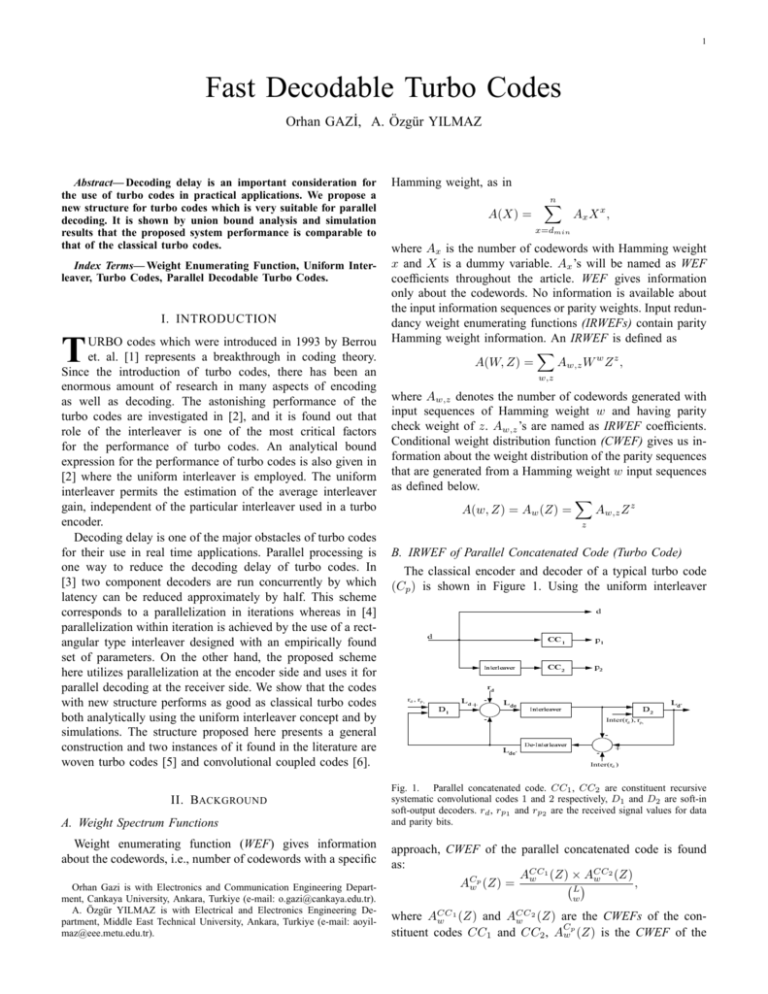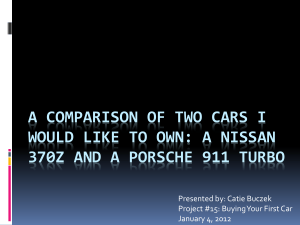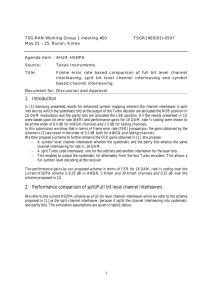Fast Decodable Turbo Codes - METU | Department Of | Electrical
advertisement

1 Fast Decodable Turbo Codes Orhan GAZİ, A. Özgür YILMAZ Abstract— Decoding delay is an important consideration for the use of turbo codes in practical applications. We propose a new structure for turbo codes which is very suitable for parallel decoding. It is shown by union bound analysis and simulation results that the proposed system performance is comparable to that of the classical turbo codes. Index Terms— Weight Enumerating Function, Uniform Interleaver, Turbo Codes, Parallel Decodable Turbo Codes. I. INTRODUCTION T URBO codes which were introduced in 1993 by Berrou et. al. [1] represents a breakthrough in coding theory. Since the introduction of turbo codes, there has been an enormous amount of research in many aspects of encoding as well as decoding. The astonishing performance of the turbo codes are investigated in [2], and it is found out that role of the interleaver is one of the most critical factors for the performance of turbo codes. An analytical bound expression for the performance of turbo codes is also given in [2] where the uniform interleaver is employed. The uniform interleaver permits the estimation of the average interleaver gain, independent of the particular interleaver used in a turbo encoder. Decoding delay is one of the major obstacles of turbo codes for their use in real time applications. Parallel processing is one way to reduce the decoding delay of turbo codes. In [3] two component decoders are run concurrently by which latency can be reduced approximately by half. This scheme corresponds to a parallelization in iterations whereas in [4] parallelization within iteration is achieved by the use of a rectangular type interleaver designed with an empirically found set of parameters. On the other hand, the proposed scheme here utilizes parallelization at the encoder side and uses it for parallel decoding at the receiver side. We show that the codes with new structure performs as good as classical turbo codes both analytically using the uniform interleaver concept and by simulations. The structure proposed here presents a general construction and two instances of it found in the literature are woven turbo codes [5] and convolutional coupled codes [6]. II. BACKGROUND A. Weight Spectrum Functions Weight enumerating function (WEF) gives information about the codewords, i.e., number of codewords with a specific Orhan Gazi is with Electronics and Communication Engineering Department, Cankaya University, Ankara, Turkiye (e-mail: o.gazi@cankaya.edu.tr). A. Özgür YILMAZ is with Electrical and Electronics Engineering Department, Middle East Technical University, Ankara, Turkiye (e-mail: aoyilmaz@eee.metu.edu.tr). Hamming weight, as in A(X) = n X Ax X x , x=dmin where Ax is the number of codewords with Hamming weight x and X is a dummy variable. Ax ’s will be named as WEF coefficients throughout the article. WEF gives information only about the codewords. No information is available about the input information sequences or parity weights. Input redundancy weight enumerating functions (IRWEFs) contain parity Hamming weight information. An IRWEF is defined as X A(W, Z) = Aw,z W w Z z , w,z where Aw,z denotes the number of codewords generated with input sequences of Hamming weight w and having parity check weight of z. Aw,z ’s are named as IRWEF coefficients. Conditional weight distribution function (CWEF) gives us information about the weight distribution of the parity sequences that are generated from a Hamming weight w input sequences as defined below. X A(w, Z) = Aw (Z) = Aw,z Z z z B. IRWEF of Parallel Concatenated Code (Turbo Code) The classical encoder and decoder of a typical turbo code (Cp ) is shown in Figure 1. Using the uniform interleaver rd , rp 1 Inter(rd ), rp1 Inter(rd ) Fig. 1. Parallel concatenated code. CC1 , CC2 are constituent recursive systematic convolutional codes 1 and 2 respectively, D1 and D2 are soft-in soft-output decoders. rd , rp1 and rp2 are the received signal values for data and parity bits. approach, CWEF of the parallel concatenated code is found as: 1 2 ACC (Z) × ACC (Z) w p , AC ¡L¢ w w (Z) = w 1 ACC (Z) w 2 ACC (Z) w where and are the CWEFs of the conC stituent codes CC1 and CC2 , Awp (Z) is the CWEF of the 2 parallel concatenated code. L is the interleaver size, w and z are the Hamming weights of the information and parity sequences, respectively. We obtain the IRWEF of the code Cp as: k X p ACp (W, Z) = W w AC w (Z), w=1 where k is the length of the input information sequences. A performance upper bound to the bit error probability for the maximum likelihood soft decoding of the code in an AWGN channel of double sided noise power spectral density N0 /2 is found as below [2] Pb (e) ≤ k X w w C W Aw (Z) |W =Z=e−Rc Eb /No . k w=1 This is further simplified as 1X Pb ∼ Dm erf c( = 2 m (1) m Rc Eb ), No (2) III. PARALLEL D ECODABLE T URBO C ODES (PDTC) Our proposed structure is seen in Figure 2. The input information sequence is sent to a serial to parallel converter to form subsequences, and these subsequences are encoded using recursive systematic convolutional codes (RSCs). N is the number of RSCs in the upper cluster, M is the number of RSCs in the lower cluster. The decoder is depicted in Figure 3. Serial to parallel and parallel to serial converters are employed in this structure. Decoders D11 , . . . , D1N and D21 , . . . , D2M can be run in parallel. This reduces decoding delay considerably. Woven turbo codes are an instance of this general structure where non-recursive convolutional codes are employed for the upper and lower cluster codes and a rectangular interleaver is used. If convolutional codes and block codes are used for the upper and lowers clusters respectively and separate interleavers are employed for the lower cluster branches we get the convolutional coupled codes [6]. d CC11 S/P . . . P/S p1 P/S p2 CC1N CC21 Interleaver S/P Fig. 3. PDTC Decoder. D1i , D2j (i = 1 . . . N, j = 1 . . . M ) are the decoders for RSCs CC1i and CC2i respectively. rd , rp1 and rp2 are the received signal values for data and parity bits. A. Decoding Delay and Hardware Complexity r Eb where Rc is the code rate, N is the bit energy to noise o ratio of the AWGN channel, Dm is obtained from the IRWEF coefficients according to X w Dm = Aw,z . (3) k z+w=m d . . . CC2M Let c and t be the computational complexity and latency of a single stage of the code trellis. In a classical turbo code, for a given transmit data vector of length L, two log-MAP decoders are needed. Both decoders have a computational complexity of (c.L) and a time delay of (t.L). In total, the complexity of each iteration is (c.2L) and the time delay is (t.2L). In PDTC the use of separate log-MAP decoders for each constituent code makes parallel processing operation possible. Assuming that M = N , all decoders in the first and second decoder clusters have a complexity of (c.L/N ) and a time delay of (t.L/N ). The total computational complexity is (c.2L) and the decoding delay is (t.2L/N ). As seen from this discussion, the decoding delay is reduced by a factor of N while keeping the total computational complexity the same as before (excluding a small overhead for the serial to parallel and the opposite operations). Naturally, the decoding latency decreases in this case at the expense of increased hardware complexity as in all parallel processing operations. That is, PDTC hardware complexity is N times the hardware complexity of classical turbo codes. IV. P ERFORMANCE A NALYSIS OF PARALLEL D ECODABLE T URBO C ODES We used the (1, 5/7)octal RSC for all the constituent codes. Trellis termination is performed in each encoder where both the terminating data and parity bits are appended to the encoded sequence. This slightly decreases the overall Eb code rate and is taken into account while calculating the N 0 values both in computation of the analytical bounds and in simulations. A1i (W, Z)’s are the IRWEF’s of the constituent codes CC1i (i = 1, . . . , N ), similarly A2i (W, Z)’s are the IRWEF’s of the constituent codes CC2i (i = 1, . . . , M ). A1 (W, Z), A2 (W, Z) are the IRWEF of the equivalent upper and lower codes respectively. Since the information bits are independent, these IRW EF ’s can be evaluated as A1 (W, Z) = N Y A1i (W, Z) i=1 Fig. 2. PDTC Encoder. CC1i , CC2i are constituent RSCs. S/P and P/S are the serial to parallel and parallel to serial converters. A2 (W, Z) = M Y i=1 A2i (W, Z). 3 We evaluated IRWEF’s for different lengths of input information sequences. Once IRWEF’s of the PDTC’s are available, the uniform interleaver analytical bound approach can be applied and equations (2), (3) can be used to determine upper bounds. Analytical bounds for different interleaver lengths and N, M values are shown in Figures 4, 5. In Fig. 4 the analytical −2 −2 10 −3 10 −4 10 M=N=1 M=N=8 M=N=16 M=N=32 10 M=N=8 M=N=4 M=N=1 BER Analytical Bounds for PDTCs 0 10 PD−Turbo Code Performance Graph −1 10 −5 Interleaver Size = 256 10 −4 10 −6 10 −6 Pb(e) 10 −7 10 −8 10 −10 0 0.2 0.4 0.6 Eb/N0 in dB 0.8 1 1.2 Fig. 6. PD-Turbo code performance graph. Interleaver Size = 2048. N and M are the number of constituent encoders in upper and lower clusters. S-Random (S=20) interleaver is used. Iteration number=12 10 −12 10 −14 10 0 1 2 3 4 5 E /N in dB b 6 7 8 9 10 0 Fig. 4. Analytical bounds for PDTCs using uniform interleaver approach. Constituent codes are trellis terminated. Analytical Bounds for PDTCs 0 10 M=N=1 M=N=8 M=N=16 M=N=32 M=N=64 −2 10 Interleaver Size = 2048 −4 10 −6 b P (e) 10 −8 10 −10 10 −12 10 −14 10 0 1 2 3 4 5 E /N in dB b 6 7 8 9 10 0 Fig. 5. Analytical bounds for PDTCs using uniform interleaver approach. Constituent codes are trellis terminated. bounds for a number of M = N values are depicted. The code rates are readily calculated by L/(3L + 4(M + N )). The classical turbo code corresponds to M = N = 1. It is seen that there is a rise in the error floor with increasing M and N . However, when a larger interleaver size is used as in Fig. 5, it is seen that PDTC error floor is almost the same as that of the classical turbo code for moderate M and N values. When asymptotics of the bounds are inspected, i.e., at very high SNR, it is observed that the bounds are off from each other by an amount directly related to code rates. This suggests that the parallelized codes have similar WEFs and the rise in error floors is mainly due to rate loss stemming from trellis termination. The rise in error floor is more visible for large values of M and N but diminishes as interleaver size increases. Hence, we can choose larger M and N values with larger interleaver sizes and gain more in decoding delay. Simulation results of the proposed system is depicted in Fig. 6. It is seen from Fig. 6 that the PDTC performance is almost the same as that of the classical turbo code along with a slight rise in error floor predicted analytically.. V. CONCLUSION In this article we propose a new turbo coding scheme which is suitable for parallel processing. We showed using the uniform interleaver assumption and by simulations that the proposed codes perform as well as classical turbo codes. The decoding delay is reduced by a factor of the number of parallel branches. This provides a significant advantage in practical applications. ACKNOWLEDGMENT The authors would like to thank Dr. Emre Aktaş, who is with Hacettepe University Electrical and Electronics Engineering Department, for his invaluable suggestions. R EFERENCES [1] C. Berrou, A. Glavieux, P. Thitimajshima: ”Near Shannon limit errorcorrecting coding and decoding : turbo-codes,” Proc. of IEEE Int. Comm. Conf. pp. 1064-1070, Geneve, May 1993. [2] S. Benedetto, G. Montorsi, Unveiling Turbo Codes: Some Results on Parallel Concatenated Coding Schemes, IEEE Trans. on Inf. Theory, Vol. 42, No. 2, March 1996. [3] Wang, Y.; Zhang, J.; Fossorier, M.; Yedidia, J.S.; ”Reduced latency turbo decoding,” SPAWC, IEEE 6th Workshop on 5-8 June 2005 Pages:930-934 [4] Berrou, C.; Saouter, Y.; Douillard, C.; Kerouedan, S.; Jezequel, M.; ”Designing good permutations for turbo codes: towards a single model,” IEEE Int. Conf. on Comm., Vol. 1, 20-24 June 2004 Pages:341-345 [5] J. Freudenberger, M. Bossert, V. Zyablov, S. Shavgulidze, ”Woven Turbo Codes,” Seventh International Workshop on Algebraic and Combinatorial Coding Theory, 18-24 June, 2000, Bansko, Bulgaria. [6] S. Chaoui, ”Convolutional Coupled Codes,”, Ph.D. Dissertation, February 2003.





